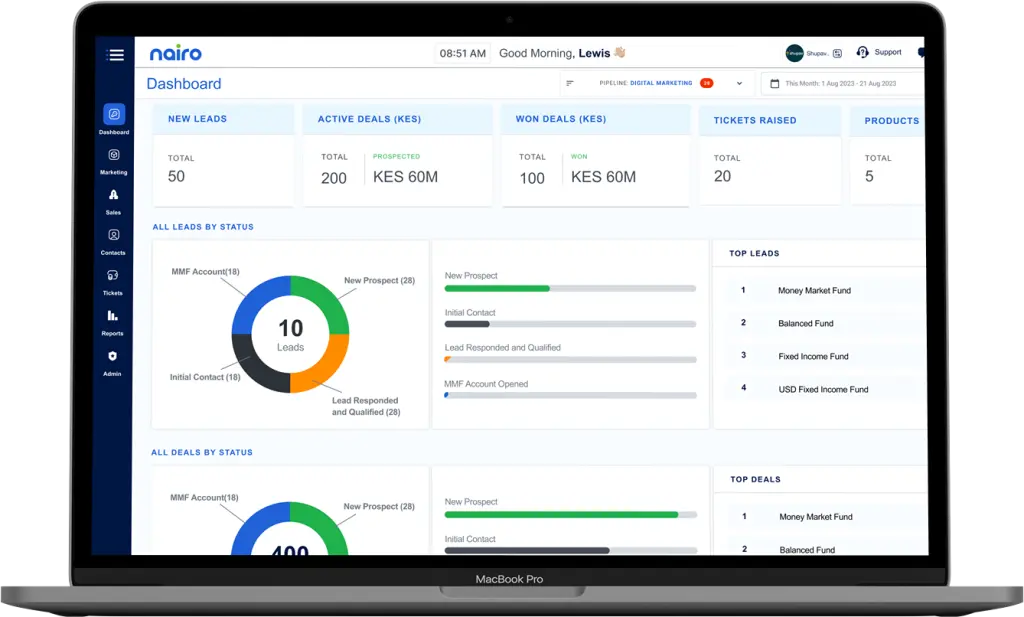You might be thinking, “Our business is doing okay without a fancy CRM system. Why fix what isn’t broken? We’re saving money by not adding another software expense.” It’s a common sentiment, especially among cost-conscious SMEs. However, not using a CRM has its costs – and they are often much higher than the investment in a good CRM.
Foregoing a CRM can be like trying to save pennies while dollars slip through your fingers. These costs aren’t always obvious on the surface, but they manifest in lost sales, wasted time, and stunted growth. Let’s break down the real cost of not using a CRM:
Missed Sales Opportunities (and Lost Revenue)
The most immediate cost of not having a CRM is lost sales – opportunities that were right there but slipped away. How does this happen?
- Slow or No Follow-Up: Without a structured system, leads and inquiries often don’t get timely attention. Perhaps an email from a potential client sits in someone’s inbox for days. By the time you respond, the lead’s gone cold or gone to a competitor. Studies show contacting a new lead within 5 minutes makes you 21 times more likely to qualify them than waiting just 30 minutes. Now imagine if you’re following up in hours or days – you’re losing a huge conversion edge.
- Leads Falling Through Cracks: In a business without a CRM, it’s common that only a fraction of incoming leads ever get properly contacted. Perhaps an email inquiry gets overlooked, or a phone message gets misplaced. One eye-opening statistic found that on average, companies only contact 27% of their leads at all. That means 73% of potential deals are ignored! This could be due to disorganized tracking or assuming someone else handled it. Every lead that doesn’t get followed up is literally money left on the table. If even one of those leads was a big client that would have closed, you can calculate the revenue missed.
- Inconsistent Sales Efforts: Without a CRM’s structured pipeline, your sales approach might be haphazard. You could be focusing on deals that are unlikely to close while forgetting high-potential ones. The lack of visibility means you might not prioritize well. The result: lower overall sales. Companies using CRM report higher conversion rates and more deals won – for instance, one source notes CRM can increase sales by up to 29% on average. If you’re not using one, you might be missing out on that uplift.
- Poor Customer Experience = Lost Sales: A prospect might talk to your sales rep one week, then call in a week later and have to re-explain who they are because you don’t have a shared system showing their info. This makes your company look disorganized. Prospects notice these things. If you can’t keep your own team aligned, will you handle their account smoothly? Some will walk away. A CRM ensures everyone has the info at hand to treat prospects and customers professionally and personally. Without it, you risk appearing forgetful or impersonal – which can directly cost you deals.
Bottom line: The revenue you lose from missed or mishandled opportunities can far exceed what a CRM would cost. It’s the unseen “leakage” in your sales funnel that adds up over time.
Wasted Time and Lower Productivity (Time is Money)
Another hidden cost of not having a CRM is how much time your team might be wasting on inefficient processes:
- Manual Data Hunting: How many minutes (or hours) do team members spend looking for contact information, scrolling through old emails to recall what was said, or updating multiple Excel files? All that is non-selling time. Sales reps on average spend 63% of their time on non-revenue tasks when they don’t have efficient systems. This is time they could spend finding or engaging customers. If each rep’s inefficiency costs you even one lost sale a month, multiply that by 12 months and several team members – the financial impact becomes clear.
- Duplicated Effort: Without a central CRM, two people might unknowingly reach out to the same prospect, or multiple employees might enter the same data in different places. Redundant work is wasted work. It’s not just annoying – it’s a salary cost doing zero to grow your business.
- Longer Training and Ramping: Think about onboarding new employees. If you lack a CRM, a new salesperson must learn your “system” (which might be a convoluted mix of spreadsheets, notebooks, and asking colleagues for info). They’ll take longer to ramp up to full productivity. That ramp-up time is essentially lost potential sales. A CRM with all customer data and processes documented can slash training time – new hires get up to speed faster, contributing to revenue sooner.
- Firefighting and Damage Control: With no CRM, things get forgotten, customers slip through cracks, and then you spend time doing damage control – apologizing to a client you neglected, rushing to fulfill a request you overlooked, or hastily compiling data that an unhappy customer or your boss suddenly wants. These situations are stressful and time-consuming. They take you away from proactive work (like selling or strategic planning) into reactive mode. That opportunity cost – the beneficial work you could have done instead – is hard to quantify but very real.
If time = money, then wasted time = lost money.
A CRM greatly reduces these inefficiencies by organizing information and automating routine tasks. The cost of not having that is everyone spending extra hours (which equates to paying salaries for less output).
Customer Churn and Less Loyalty
What about your existing customers? Not using a CRM can hurt here too, costing you in customer lifetime value:
- Lack of Personal Touch: Customers today expect you to remember their history – what they bought, what issues they had, what they prefer. If you’re not systematically tracking this, you might treat loyal customers like strangers each time. That erodes loyalty. They might take their business elsewhere where they feel more valued. Losing a repeat customer or having a client shorten their relationship with you has a big cost – it’s often said it costs far more to acquire a new customer than to retain an existing one.
- Missed Upsell/Cross-sell Opportunities: Your current clients might have additional needs you could fulfill, but if you aren’t tracking their account progress, you might not identify these chances. A CRM could, for example, remind you that a customer bought a 1-year subscription that’s about to expire (time to pitch a renewal or upgrade), or show that one client hasn’t purchased a certain service that others in their category usually do (cue to introduce it to them). Without those prompts, you don’t make those sales. That’s revenue you could have easily won with an appropriate system in place.
- Poor Service Leading to Churn: If a customer has to repeat their issue every time they contact you because there’s no centralized log of their past interactions, they will get frustrated. Or if a key follow-up that was promised falls through the cracks, that damages trust. Eventually, they leave. The cost of churn is huge: not only do you lose their future revenue, but you might also suffer bad word-of-mouth. Using CRM for support and service (even a basic one) ensures you deliver consistent, reliable service that keeps customers happy. Not using one increases the risk of mistakes that can drive customers away.
- Lost Referrals: Happy customers refer others; unhappy or indifferent customers don’t. So, by not nurturing your customers with a CRM, you might be indirectly losing referral business too. That’s a hidden opportunity cost – the new customers you never gained because the existing ones weren’t delighted.
There’s a famous business stat that a small increase in customer retention (5%) can boost profits by 25% to 95% (Bain & Co study). CRM is a tool to drive that retention. Not leveraging it means you’re likely leaving those profit gains on the table.
Employee Burnout and Turnover Costs
We discussed in a previous article how the right CRM can alleviate sales team burnout. The flip side is also true: no CRM can contribute to employee frustration:
- Drudgery: Top talent in sales wants to spend time selling and earning commission, not doing admin work. If they feel bogged down in chaotic processes, they may burn out or underperform.
- Lack of Achievement: When systems are poor, even great salespeople can miss targets (not because they lack skill, but because support is lacking). Consistently missing goals due to such factors is demoralizing; you might see higher turnover as a result.
- Onboarding Chaos: New hires might feel overwhelmed or discouraged if they inherit a disorganized system. Some might quit when they realize they don’t have the tools to succeed.
- Turnover Costs: When a salesperson leaves, it costs money to hire and train a replacement, and in the interim, territory might be uncovered. Moreover, departing employees might take some client relationships with them if a CRM wasn’t capturing all interactions. That’s a double hit – cost of replacement and potential loss of clients or institutional knowledge.
In short, not investing in a CRM can mean investing in hiring recruiters, training programs, and overtime for remaining staff to cover gaps – all expensive outcomes that could be mitigated by giving your team a solid platform to excel with.
Competitive Disadvantage
In today’s market, using technology efficiently is often a competitive advantage. If your competitors adopt a CRM and you don’t:
- They might be responding to leads faster (snagging prospects before you do).
- They could be nurturing relationships in a more personalized way (stealing some of your customers with VIP treatment).
- They’ll likely have better sales forecasting and planning (meaning they’ll strategize more effectively, while you might be guessing).
- Their team will appear more professional and on-the-ball to clients.
Over time, this can translate to a shift in market share. The cost here is the business you could have won if you were on equal footing technology-wise.
For example, if two companies offer similar services at similar prices, the one that provides a smoother, more responsive experience will win more deals. CRM is a big part of creating that smooth experience internally, which then reflects externally.
Quantifying the Invisible Losses
It’s hard to put an exact dollar figure on the cost of not using a CRM, because many factors are interlinked. But consider doing a rough calculation for your business:
- How many leads did you generate last month? How many did you convert to sales? If you converted, say, 10 out of 100 leads (10%), but with better follow-up (enabled by CRM) you could convert 15 out of 100 (15%), that’s 5 extra sales. What is the average value of a sale for you? Multiply that out, and then multiply by 12 for a year. The number will likely dwarf the annual cost of most CRM subscriptions.
- How much time do your sales/support staff spend weekly on admin or looking for info? If a CRM could cut even 2 hours per week per employee, that’s 2 hours x 52 weeks = 104 hours a year. Multiply by an hourly wage to see monetary value. Then think, those 104 hours could instead be spent selling or improving the business – what revenue could that generate? Again, likely more than what the CRM costs.
- Consider one lost customer or one mistaken deal and what it cost you. Nearly every business has at least one painful story (“If we had followed up with X, we would have closed that $50k deal”). That single event might have paid for a CRM system for years.
When you start adding it up, it becomes clear that doing nothing is often the most expensive choice. It’s just that the costs of doing nothing are stealthy – they accumulate slowly and silently, whereas buying software is a visible line item expense. But smart business leaders look at ROI. A CRM doesn’t cost money; when properly used, it makes or saves far more money than it costs.
Turning the Tables: Invest to Save (and Earn)
The good news is that all these costs we’ve talked about are avoidable. The solution is straightforward – implement a CRM and use it. The moment you do, you plug the leaks:
- Every lead is logged and gets attention (no more easy money slipping away).
- Your team works smarter, not harder (time is utilized effectively).
- Customers feel the love (they stick around and spend more).
- Your employees have the tools to succeed (reducing burnout and exits).
- You keep up (or surpass) the competition on the customer service front.
Think of a CRM not as an expense, but as an investment or even an insurance policy against the very losses we outlined. It’s an investment that has been shown to yield high returns – studies have shown that on average, CRM pays back about $8.71 for every $1 spent. Where else can you get that kind of ROI?
Conclusion: Can You Afford Not to Have a CRM?
In summary, the question isn’t “can we afford a CRM?” – it’s “can we afford not to have one?” The risks and costs of staying disorganized are just too high in today’s fast-paced, customer-centric business environment.
If you recognize some of the issues discussed in your own operations, it’s time to take action. The sooner you patch these leaks, the sooner you’ll see the impact in your sales figures, customer reviews, and team morale.
And adopting a CRM doesn’t have to be daunting or expensive. Solutions like NairoCRM are emerging precisely to make this transition easier for businesses like yours. We understand the common pain points (because we’ve been there), and we’re building a CRM that minimizes those hidden costs from day one. By joining the NairoCRM waitlist and eventually using our platform, you’re investing in reclaiming all that lost revenue and wasted effort.
Don’t let “hidden costs” continue to quietly drain your business. Shine a light on them, address them with the right tools, and watch your business thrive. Join the NairoCRM waitlist now to future-proof your operations. Early access members will get the benefit of our guidance on implementation and exclusive early-bird perks – all aimed at ensuring you quickly see the positive difference (and real savings) that a proper CRM can bring. Take control of your growth and stop paying the high price of inaction.





